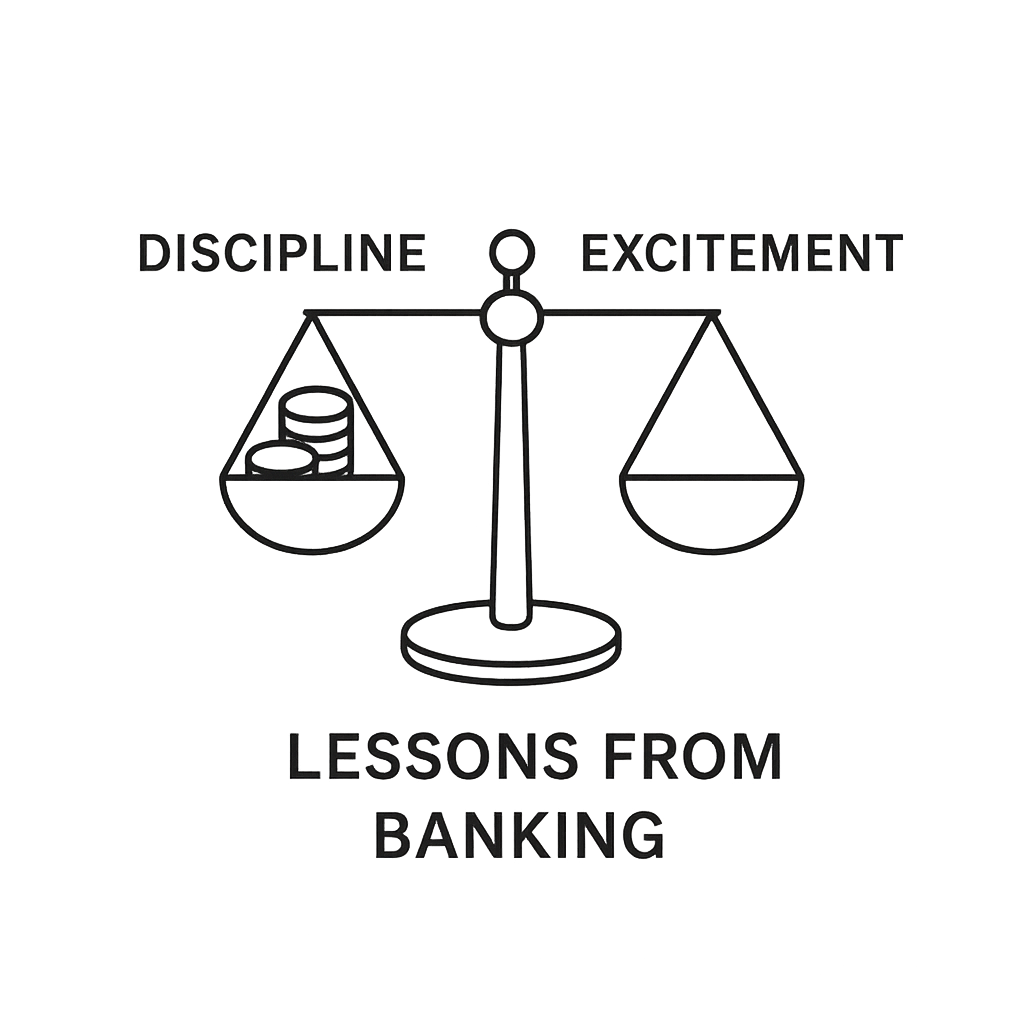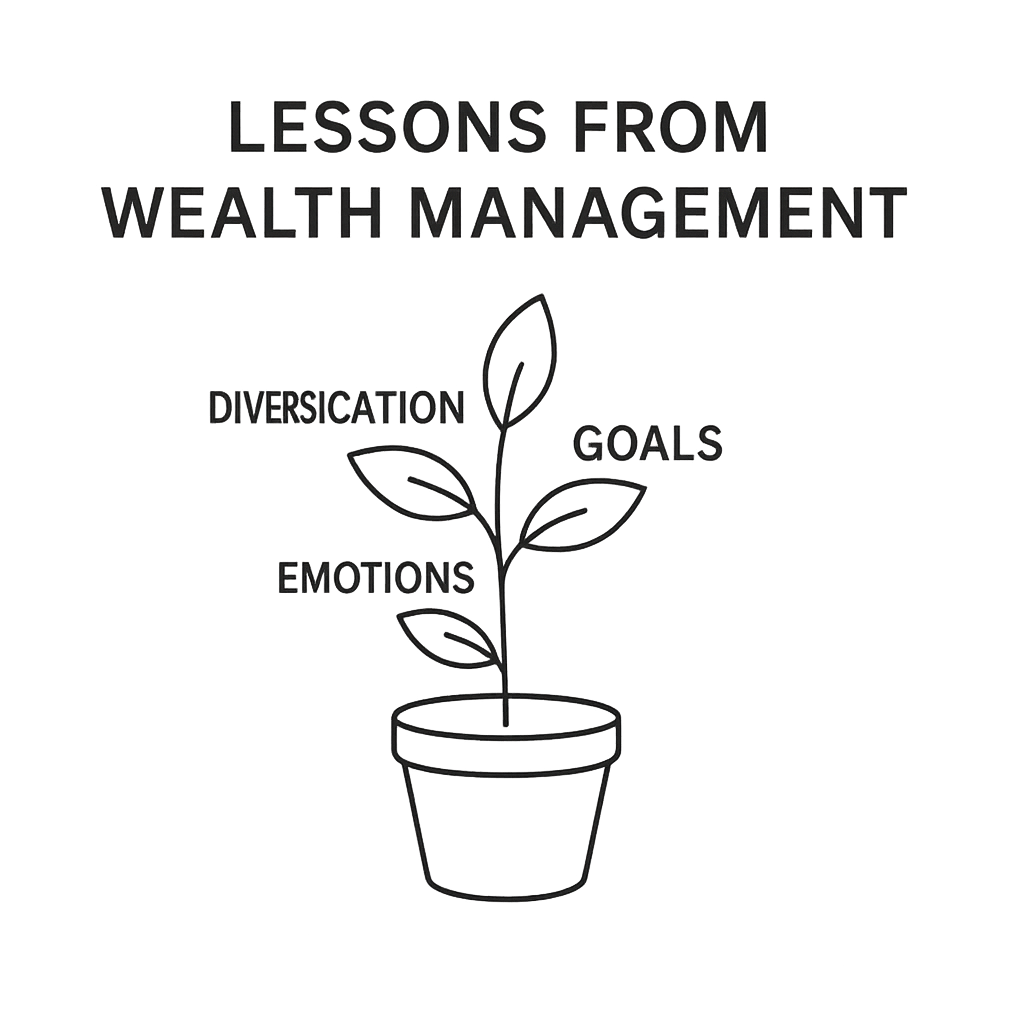Introduction: From Numbers to Narratives
When I first entered the world of banking, I thought my path was fixed — a stable career, a respectable position, and a life surrounded by numbers. Banking gave me structure, discipline, and financial stability. Yet, something always felt incomplete.
Every day, I saw people walk into the bank with unique financial stories. Some deposited their hard-earned savings with pride, some anxiously applied for loans, while others desperately sought help because their finances had spiraled out of control. I realized that banking gave people products, but it rarely gave them clarity.
That gap — between what clients really needed and what banking could provide — made me rethink my career. Over time, my journey took me from a banker handling transactions to a wealth manager guiding lives. And along the way, I discovered lessons that changed how I see money, risk, and success.
In this blog, I want to share my journey and the lessons I learned, so that you too can apply them in your wealth journey.
Table of Contents
Chapter 1: Banking Days – My First Lessons with Money
Banking was my first serious exposure to how money works in people’s lives. It was a front-row seat to human behavior with finances.
I saw disciplined savers who quietly built financial security over decades.
I saw high-income professionals who lived paycheck to paycheck because their expenses always outgrew their salaries.
I saw families in distress because one medical emergency wiped out their savings.
The biggest lessons I took away from those years were:
Cash flow is everything. Income alone doesn’t define wealth; what matters is how much you keep after expenses.
Emergency funds are non-negotiable. Many clients took loans at high interest simply because they lacked a rainy-day fund.
Credit can make or break lives. I saw people flourish with good credit and collapse with bad debt.
Banking was a great teacher. But it also revealed its limitations. Most clients didn’t just need an FD or a loan; they needed a plan, a guide, someone to help them connect the dots between today’s money decisions and tomorrow’s dreams.

Chapter 2: The Shift to Wealth Management
The turning point came when I realized that banking was often reactive. A client came with a problem; we offered a product. But what about proactive planning? What about long-term goals like retirement, children’s education, or financial freedom?
That’s when I decided to step into wealth management. It wasn’t an easy choice. Banking was comfortable, structured, and safe. Wealth management was entrepreneurial, uncertain, and required me to earn my clients’ trust from scratch.
I invested in myself by pursuing global certifications:
Certified Wealth Manager (CWM®)
Certified Financial Planner (CFP®)
CFA (Level 2 candidate)
These weren’t just qualifications — they represented a shift in mindset. I no longer wanted to sell financial products; I wanted to help people design their financial future.
Chapter 3: Lessons Banking Taught Me (That I Still Use Today)
Even though I left banking, I carried forward valuable lessons:
Discipline beats excitement. I saw recurring deposits quietly build wealth while risky stock tips often led to losses.
Numbers reveal the truth. A client might justify spending, but their bank statement always told the real story.
Short-term thinking is dangerous. Many people obsessed over this quarter’s returns instead of long-term compounding.
One client I recall earned well but juggled multiple credit cards, personal loans, and speculative stock investments. Despite his income, his net worth was shrinking. That taught me an important lesson: before chasing returns, get your foundations right — savings, insurance, debt control.

Chapter 4: Lessons Wealth Management Taught Me (A New Paradigm)
Wealth management expanded my world. It shifted my focus from products to people, from transactions to transformations.
Here are lessons that stood out:
SIPs Build Wealth, Not Just Portfolios. Systematic Investment Plans are not about timing the market; they are about building financial discipline and letting compounding work.
Diversification is Survival. A client who put everything into real estate struggled with liquidity when the market slowed. Once we diversified his portfolio into mutual funds, bonds, and equity, he gained stability.
Personalization Matters. A 25-year-old techie investing for early retirement and a 55-year-old doctor planning succession need entirely different strategies. Wealth management is never one-size-fits-all.
Money is Emotional. I realized many investors fear losses more than they value gains. My role often became part advisor, part coach.
These lessons reinforced one truth: Wealth management is not about beating the market; it is about helping people achieve peace of mind.

Chapter 5: Banking vs Wealth Management – The Real Difference
If I had to summarize the difference in one line:
Banking is about transactions. Wealth management is about transformation.
Banking provides accounts, loans, and deposits.
Wealth management provides strategies for financial independence, retirement, tax efficiency, and legacy.
Banking is short-term; wealth management is lifelong.
This shift was liberating for me. I was no longer just helping clients earn a percentage of interest — I was helping them fund weddings, retire with dignity, send children abroad, and live debt-free lives.
Chapter 6: Why Certifications Matter in Wealth Management
Many ask me: “Why invest so much in certifications?”
The answer is simple: Finance is built on trust. A client entrusts me with their dreams, their life savings, their future. That responsibility demands expertise.
CWM® gave me a global perspective on wealth strategies.
CFP® trained me in holistic financial planning — not just investments, but insurance, retirement, estate, and tax planning.
CFA (Level 2) sharpened my analytical edge, ensuring I understand risk and investment fundamentals at the deepest level.
These are not badges. They are a commitment — to ethics, to knowledge, and to putting clients first.
Chapter 7: The Birth of FinBees Wealth
With these lessons and experiences, I founded FinBees Wealth. The name represents what I believe in: just like bees collect nectar from many flowers to make honey, investors must carefully choose and diversify their investments to create wealth.
At FinBees, our philosophy is simple:
“Expertly Chosen, Wisely Invested.”
Here’s what we focus on:
Tools for clarity: SIP and retirement calculators that anyone can use.
Transparency: No jargon, no hidden agendas.
Goal-based investing: Every rupee must serve a purpose — whether it’s a child’s education or a peaceful retirement.
Chapter 8: Actionable Lessons for Every Investor
Here are five lessons you can apply today, regardless of your income or background:
Start early. Even ₹500 invested in a SIP can snowball into lakhs over time.
Avoid lifestyle debt. If you can’t pay cash, reconsider if you need it.
Diversify smartly. Spread across equity, debt, and real estate.
Review your plan annually. Life changes; your portfolio should too.
Plan taxes, don’t just save them. Integrate tax planning into wealth creation.
Conclusion: From Transactions to Transformation
My journey from banking to wealth management was more than a career change; it was a mindset shift. Banking taught me discipline, but wealth management taught me vision.
Today, when I sit with clients, I don’t just see numbers on a balance sheet. I see weddings, retirements, dreams, and peace of mind. That’s the real power of wealth management.
If there’s one lesson I want to leave you with, it’s this:
Wealth is not built overnight. It is built consistently, wisely, and patiently.
Ready to begin your journey?




